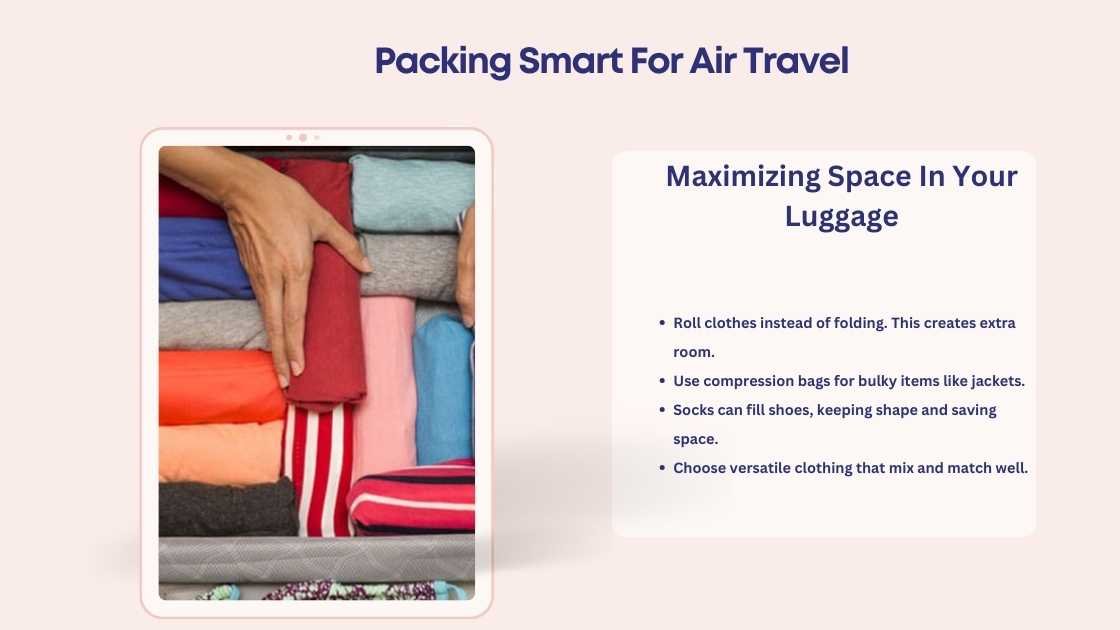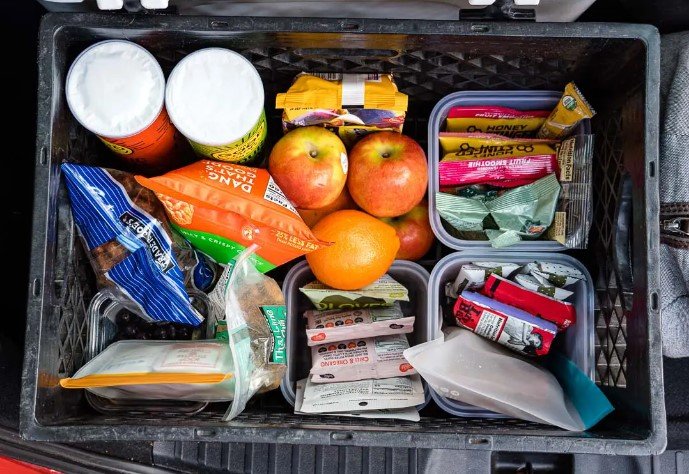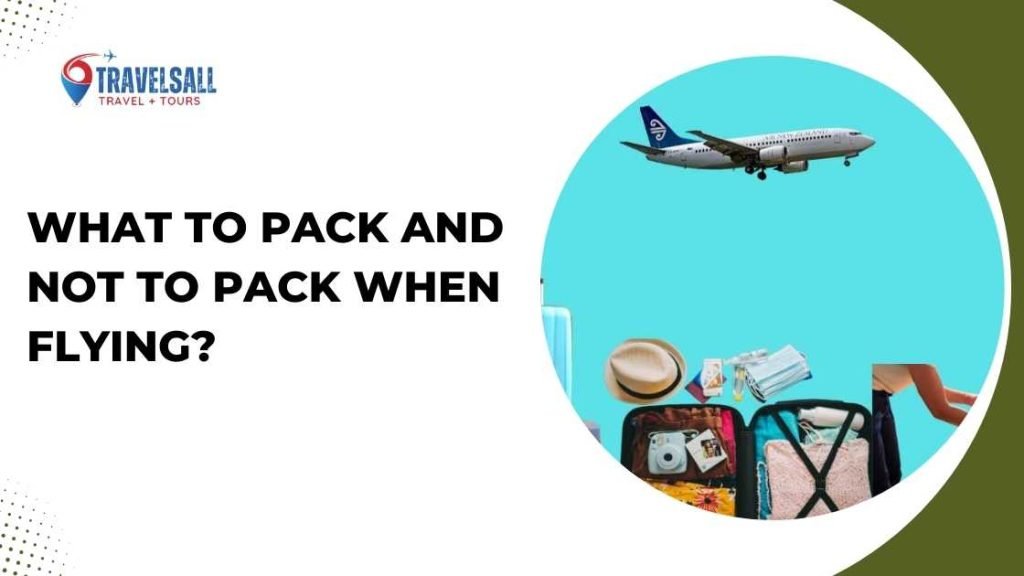Pack essentials like clothing, personal items, and chargers; avoid prohibited items like liquids over 3.4 ounces, sharp objects, and flammable materials. Review airline guidelines for specifics on what to pack and what to leave behind.
When you go on an airplane, it’s important to pack smartly for a comfy and easy trip. Think about what you put in your bag to make checking in faster and follow the rules.
Choose clothes that work for the weather and things you’ll do where you’re going. Don’t forget to bring chargers for your gadgets so you can stay in touch.
When preparing for air travel, it’s essential to navigate the intricacies of airport regulations. What to pack and not to pack when flying can be a bit perplexing, so it’s crucial to familiarize yourself with the latest guidelines.
Take the time to educate yourself on the most recent rules governing the contents of your bags. Having a clear understanding of what is permissible to bring on the plane will spare you any surprises during the security screening process.

This way, your journey can start without any problems. Always look at the list of things you’re not allowed to bring and the rules for liquids.
This helps you follow the airline’s rules. If you spend a little time getting ready, you can have a less stressful trip and enjoy your flight more.
Table of Contents
TogglePacking Smart For Air Travel
Packing for air travel is like a puzzle. Smart choices save trouble. Follow these tips to start your journey right.

Maximizing Space In Your Luggage
Keep your belongings organized and accessible. Use every inch wisely. Check out these easy tips:
- Roll clothes instead of folding. This creates extra room.
- Use compression bags for bulky items like jackets.
- Socks can fill shoes, keeping shape and saving space.
- Choose versatile clothing that mix and match well.
Multipurpose items are the way to go. A sarong, for example, can double as a blanket or a scarf.
Complying With Airline Baggage Policies
Rules vary by airline. Always check baggage allowances before packing. Remember these key points:
| Item | Carry-On | Checked Bag |
|---|---|---|
| Liquids (100ml or less) | Yes | Yes |
| Sharp Objects | No | Yes (packed safely) |
| Electronic Devices | Yes | Yes |
Use travel-size containers for liquids. Pack chargers, medications, and important documents in your carry-on. This keeps them handy and secure.
Remember, breaking rules may cause delays. Check twice, fly easy!
Essentials For Your Carry-on
Flying soon? Preparing your carry-on with essentials ensures a smooth trip.
Packing smart can make flying less stressful. Keep essentials within reach.
Must-have Documents And IDs
Travel documents and IDs are non-negotiable. Without them, you won’t get far.
- Passport for international flights.
- Driver’s License or other government-issued ID.
- Boarding Pass, printed or on your device.
- Visa if required for your destination.
- Travel Insurance for peace of mind.
- Health documents, like vaccine certificates.
In-flight Comfort Items
Comfort is key during flights. Smart selections promise a relaxed journey.
| Item | Reason |
|---|---|
| Noise-cancelling headphones | Drown-out cabin noise. |
| Travel pillow | Neck support for sleep. |
| Compact blanket | Stay warm, and cozy. |
| Entertainment | Books, tablets for movies. |
| Snacks | Tasty, healthy options. |
| Water bottle | Stay hydrated in flight. |
Remember, liquid restrictions apply. Keep items under 3.4 ounces (100 milliliters).
Managing Liquids And Gels

Welcome to the careful world of packing liquids and gels for your flight! It’s like playing a special game of Tetris with your carry-on. But don’t worry! Getting ready for your trip will be easier if you know how to deal with liquids and gels.
This will help make sure your important stuff stays with you when you go through security. Let’s check out the rules and tips to help you smoothly pass through security checks.
Navigating Tsa’s 3-1-1 Rule
Getting through airport security is easy if you remember the TSA’s 3-1-1 rule. Just think of it like this: all your liquids and gels need to fit in a small bag that’s 1 quart in size. Each thing in that bag should be 3.4 ounces (that’s like 100 milliliters) or less.
And you can only have one bag per person so that security can check it fast. That way, going through security is quick and stress-free!
- Liquid cosmetics: mascara, lip gloss.
- Personal care: shampoo, conditioner.
- Medications: liquid prescriptions, over-the-counter.
Packing Toiletries Efficiently
Trying to pack your stuff in a tiny bag? It’s important to pack well. First, make a list of things you use every day. Use things that can do more than one job, like shampoo and conditioner together.
Pick solid deodorants, soaps, and toothpaste to leave room for other liquids. Get small containers for lotions and creams; they’re great for travel.
| Item | Travel-Sized | Solid Alternative |
|---|---|---|
| Deodorant | Yes | Yes |
| Soap | Yes | Yes |
| Shampoo | Yes | Yes |
Get ready for your trip by putting your liquid stuff in the front pocket of your carry-on bag. This helps the people checking your stuff do it faster. Make sure you write names on your bottles so it’s easy to see.
Put things that might move around in the big bag you check, so you have room for things you need during the flight.
Tech Gadgets And Entertainment

Getting through airport security and having a good flight is all about packing smart. Your gadgets and things to have fun with are important.
They help you stay connected and have fun. It’s important to know what to bring and what to leave at home.
Chargers And Power Banks
Never forget your chargers and power banks. These small items are life savers on long flights. Your devices must stay powered. Check airline regulations for power bank capacities.
- Phone charger: A must-have in your carry-on
- Laptop cable: If you plan to work or watch movies
- Power bank: Check its capacity and airline policy
Portable Devices And Earphones
Lighten your load with portable gadgets. Tablets, e-readers, and handheld gaming consoles offer hours of fun. Pair them with your favorite earphones.
| Device | Purpose |
|---|---|
| Tablet | Books, movies, games |
| e-Reader | Thousands of books |
| Gaming console | Keep entertained |
Choose wireless earphones. They are hassle-free. Ensure they’re charged. Bring a backup pair just in case.
Clothing Choices For A Smooth Flight
Flying is fun, but it’s important to be comfy. Wear comfy clothes for a happy flight from when you go up to when you come down. Let’s talk about the best clothes to make your trip super comfy!
Layering For Changing Temperatures
Planes can get chilly, even in summer. Wear layers to stay cozy. Start with a light T-shirt or blouse. Next, add a sweater or cardigan. Finally, pack a jacket in your carry-on. You can add or shed layers as needed.
- Cotton or breathable fabric for your base layer avoids sweat.
- Wool or fleece mid-layers keep you warm and are easy to remove.
- A lightweight jacket acts as your final layer for extra warmth.
Footwear Considerations
Choose comfortable shoes for your flight. You might walk a lot in the airport. Slip-on shoes or sneakers are best. They are easy to remove at security and comfy for long walks.
| Shoe Type | Pros | Cons |
|---|---|---|
| Slip-on Shoes | Easy at security, good for walking | May lack support on long walks |
| Sneakers | Supportive, versatile | Can be slow to remove |
| Sandals | Easy to wear | Not ideal for cold cabins |
Pack socks, even with sandals. Airplane floors get cold.
Avoiding Prohibited Items
Getting ready for a trip means packing carefully. But some things can make travel tricky. If you make a mistake, it might take longer or they could take away your stuff.
It’s not fun to unpack at security. Use this guide to know what you can and can’t bring on the plane.
Common But Restricted Items
Many travelers unknowingly pack items that seem harmless, yet are restricted on flights. Avoid inconvenience by familiarizing yourself with these items:
- Batteries: Loose lithium batteries pose a risk and belong in carry-on bags only.
- Tools: Tools shorter than 7 inches can be in a carry-on. Longer ones must be checked.
- Self-defense items: Pepper spray and other such items are a no-go. Pack them in checked luggage if allowed.
- Sports equipment: Bats, clubs, and sticks must travel in checked baggage.
- Liquids, gels, aerosols: Follow the 3-1-1 rule for carry-ons. Containers of 3.4 ounces or less in a clear, quart-sized bag.
Checking Airline-specific Bans
Airlines may have their own set of rules for prohibited items. Ensure smooth travel with these steps:
- Visit the airline’s official website before packing.
- Review the ‘Prohibited Items’ section for specific guidelines.
- Check updates on rules as they change often.
Remember, certain objects may be banned outright or restricted to checked luggage. A call to customer service can clarify doubts.
Medications And Health Supplies

Getting ready to fly in an airplane needs good thinking, especially when you’re deciding what medicines and health stuff to take.
You have to pack the correct things to keep yourself healthy and feeling good while you’re up in the sky. Let’s talk about what you should bring and what you should not bring when it comes to your special medicines and first-aid stuff.
Traveling With Prescription Drugs
Packing prescription medications needs attention to detail. Always keep these in original containers with clear labels. This practice avoids confusion and ensures smooth security checks.
- Carry a copy of your prescription. This helps in case of loss or for verification purposes.
- For controlled substances or injectable medications, carry a note from your doctor confirming its necessity for your health.
- Check travel restrictions for medications for the countries you’ll be visiting, as some may have specific rules.
- Never check your medications. Always pack them in your carry-on in case you need them on the flight or if your luggage is lost.
First Aid Items And Health Essentials
Accidents happen, so it’s wise to be prepared. Pack a travel-sized first aid kit that includes basics like:
| Item | Quantity |
|---|---|
| Adhesive bandages | A variety |
| Antiseptic wipes | 5-10 packets |
| Antibiotic ointment | 1 small tube |
| Pain relievers (like ibuprofen or acetaminophen) | 1 travel-sized bottle |
| Gauze and medical tape | 1-2 rolls each |
When you pack a simple first aid kit, think about what you need for your health. Bring small versions of medicines you use, like for tummy troubles, allergies, or feeling sick in the car.
Don’t forget hand gel, cough drops, and stuff to help you get better if you’re thirsty. It’s good for your trip!
Traveling With Food And Snacks

Taking food on a trip is a good idea! It helps you have yummy and healthy snacks when you’re on a plane. But you can’t just throw everything into your bag.
There are rules to know and smart ways to pack. Make sure you understand what snacks are allowed and how to pack them the right way.
What Food Items Are Permitted
Knowing what’s allowed is crucial for a hassle-free security experience. Most solid foods pass TSA checks
but liquids and gels raise flags. You can take:
- Fruits and sandwiches are perfectly fine in your carry-on.
- Cheese and dry snacks like chips or crackers won’t cause issues.
- Chocolate and pastries are also allowed on the plane.
Remember, each country has specific rules about bringing food across borders. Always check
regulations before international flights.
Tips For Packing Perishables
For those wanting to bring perishable items, packing correctly is vital to keep your snacks fresh
and prevent potential messes.
| Packing Item | Tips for Use |
|---|---|
| Insulated Lunch Bags | Maintain cool temperatures for perishables. |
| Ice Packs | Freeze beforehand and wrap in paper towels to absorb moisture. |
| Airtight Containers | Prevent leaks and keep food sealed during the flight. |
| Zip-top Bags | Use for portion control and ease of access when snacking. |
Note: Ice packs must be frozen solid during the security screening. If they’ve started melting, TSA
may prohibit them from coming through checkpoints.
Pack smart and enjoy your food safely throughout your journey. Your stomach and wallet will
thank you.
Special Considerations For International Flights
Getting ready to go to another country means you have to do some extra planning. One important thing to think about is what to pack in your suitcase. When you fly to a different country, you have to think about things like how people there do things and the rules for the airplane. Let’s talk about two really important parts of this.
Cultural Sensitivities And Legal Restrictions
Every country has unique customs and laws that could affect your packing list. For smooth travels, be mindful of these:
- Clothing: Research local attire guidelines to avoid offending residents.
- Medications: Some over-the-counter meds may be illegal abroad. Check the destination’s embassy website for restrictions.
- Books and Media: Content that’s acceptable at home might not fly elsewhere. Authorities could seize materials they find inappropriate.
Adapting To Different Airline Regulations
Airlines have varying policies on baggage weight, size, and contents. Staying informed prevents hassles. Here’s how to adapt:
| Airline | Baggage Size Limit | Baggage Weight Limit | Liquid Rules |
|---|---|---|---|
| Airline A | 22 x 14 x 9 inches | 50 lbs (23 kg) | 100 ml per container |
| Airline B | 24 x 16 x 10 inches | 55 lbs (25 kg) | 100 ml per container |
Before packing:
- Check airline websites for baggage policy details.
- Measure and weigh your baggage to avoid extra fees.
Remember, items like batteries and sharp objects often have special airline rules. Checking these in advance saves trouble at security.
Frequently Asked Questions For What To Pack And Not To Pack When Flying
What Items Are Prohibited In Carry-on Luggage?
Prohibited items in carry-on luggage typically include sharp objects, flammable items, guns, and certain tools. It’s best to check with the airline or TSA guidelines before packing to ensure compliance with current restrictions.
How To Pack Liquids For A Flight?
To pack liquids for a flight, use travel-sized containers holding 3. 4 ounces (100 milliliters) or less. Place them in a clear, quart-sized zip-top bag. Each passenger is allowed one such bag for their carry-on luggage.
Are Electronics Allowed In Checked Baggage?
Most electronics are allowed in checked baggage, but it’s recommended to carry them in your hand luggage. This prevents damage and loss. Additionally, spare lithium batteries must always be in carry-on bags.
Can I Bring Snacks On The Plane?
Yes, you can bring snacks on the plane, but they must be solid food items. Gels or liquids must meet the 3-1-1 liquids rule. Pack snacks that aren’t messy or strong-smelling out of consideration for fellow passengers.
What Am I Not Allowed To Pack On A Plane?
You are not allowed to pack hazardous materials, such as explosives, flammable liquids, and corrosive substances, on a plane. Additionally, certain items like sharp objects, firearms, and certain sports equipment may be restricted or require special handling.
Conclusion
Getting on an airplane trip means packing smart. To easily go through check-ins and security, pack important stuff, and leave out things you’re not allowed to bring. Remember, in the sky, it’s better to have less stuff. Keep it simple, just bring what you need, and your flight will be super easy.
Happy travels!



